Know your feet
Foot Misalignment and the Body
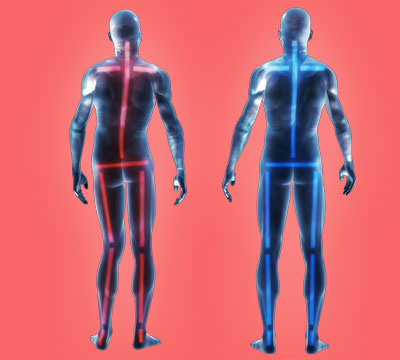 Your feet are the foundation for your entire body. When this foundation is misaligned or functioning poorly the effects can be felt throughout the body, whether in muscle and joint pain or through more serious injuries. Over 75% of the population suffers from overpronation or excessive supination, yet most of us are unaware of our own foot type and how it affects the rest of our body.
Your feet are the foundation for your entire body. When this foundation is misaligned or functioning poorly the effects can be felt throughout the body, whether in muscle and joint pain or through more serious injuries. Over 75% of the population suffers from overpronation or excessive supination, yet most of us are unaware of our own foot type and how it affects the rest of our body.
This illustration shows the many areas of the body affected by overpronation. By simply supporting the feet properly overall body alignment can be improved, alleviating pain and helping the body heal itself.
Common Foot Types
Our feet are our body’s first shock absorbers – they alternately flex and stiffen as the body moves to absorb impact, respond to uneven surfaces and act as a lever to propel the body forward. Feet can be classified into three broad categories based on how they perform in this role.
 |
 |
 |
OVER-
|
Excessive
|
Neutral |
| When the arch collapses too much and the foot rolls inward excessively, distributing weight unevenly. One of the most common foot misalignments. | When the foot leans to the outside. Weight is distributed along the outside. Also known as underpronation, over supination reduces the body’s natural shock absorbing capability. | Foot and ankle maintain a straight line. Weight is distributed evenly across the foot and heel. |
Each of your feet can be a different foot type. If you overpronate, one of your feet can pronate more than the other. Whatever your foot type, Footbalance custom-molded insoles properly support your arches in the neutral position to aid in a balanced stance and facilitate healthy foot function.
/ Overpronation
Pronation is the natural way that our feet absorb shock: when our feet strike the ground the arches flex down and in to disperse the impact.
Is pronation unhealthy?
Everyone pronates! Contrary to popular misconception it is healthy and normal. The problem begins when one or both of our feet pronate too much. When the arches flex too far inward or stay collapsed for too long pronation is considered excessive. We call this overpronation.
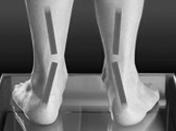
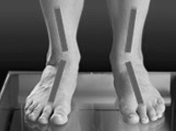 Overpronation
Overpronation
The amount of overpronation can vary from mild to severe. In severe overpronation the feet and
ankles can rotate too far inward just during standing.
Who overpronates?
Overpronation is by far the most common foot type. Pronation is not linked one-to-one with low
arches. Although pronation lowers the arches, this does not mean that only those with low arches overpronate. People with high arches can also overpronate! Some of us have always overpronated, for others overpronation develops with age, weight gain, regular standing work or intensive exercise.
How do I tell if I overpronate?
Pronounced wear on the instep side of shoe heels can indicate overpronation, however it’s best to get an accurate assessment. Footbalance retailers offer a free foot analysis to check for overpronation and help you learn more about your feet.
Why should I care about overpronation?
Overpronation can negatively affect overall body alignment. The lowering of the longitudinal arch pulls the heel bone in, causing the leg, thigh bone and hip to rotate inwards, and an anterior tilt of the pelvis. Unnecessary strain to the ankles, knees, hips and back can result.
Plantar fasciitis and inflammation, metatarsal pain, problems with the Achilles tendon, pain on the inside of the knee, and bursitis in the hip are just some of the conditions commonly associated with pronation.
What can I do about overpronation?
Studies have shown custom orthotics to be a great help for overpronation. Footbalance custom molded insoles offer you the benefits of custom orthotics at an affordable price. Our insoles properly support your feet in the neutral position to aid in a balanced stance and facilitate healthy foot function. A patented core helps strengthen foot muscles and arches to prevent a worsening of your overpronation.
Find the right Footbalance insole for you ›
/ Excessive Supination
Supination is a natural part of all walking and running. It is the way the feet propel the body forward: the foot turns or rotates outward as the heel
lifts, weighting the forefoot and toes to push-off the ground.
Is supination unhealthy?
Supination is a natural part of movement and is normal when it occurs appropriately. Supination can become harmful when it occurs for too long
or at the wrong times, or if the foot can no longer control the outward rolling. This excessive supination is what people mean when they say that
someone supinates or is a supinator. Excessive supination is also called underpronation.
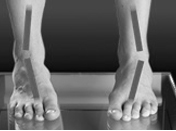
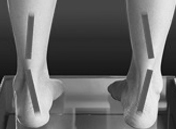 Excessive supination
Excessive supination
In excessive supination the foot rolls outward, distributing more weight along the outside of the foot and pushing the anklebone out. This causes excess strain on the ankle muscles and tendons and decreases ankle flex, reducing the foot’s natural ability to absorb shock. The smaller toes must do most of the work during push-off, decreasing efficiency of walking and running.
Is excessive supination common?
Excessive supination is the least common foot type. Some of us have had it since childhood. For
others, excessive supination is the result of prior injury or overwork to the muscles, ligaments or
tendons that stabilize the ankle, such as from a sprained ankle.
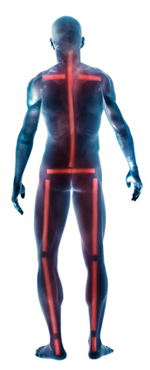 How do I tell if I am a supinator?
How do I tell if I am a supinator?
Don’t assume you are a supinator if you have high arches. It is not true that all high-arched individuals over supinate! People with high arches can overpronate, and those with low arches can over supinate. Arch rigidity and past ankle injuries are important factors, and one foot can over supinate while the other doesn’t. Excessive supination may be detected by pronounced wear on the outer side of your shoes, but it’s best to get an accurate assessment.
Footbalance retailers offer a free foot analysis to check for excessive supination and help you learn more about your feet.
Why should I care about excessive supination?
Excessive supination increases your risk of injury by decreasing shock absorption and reduces
biomechanical efficiency by making push-off is less efficient. Impact forces to the muscles and joints of the legs, hips and back increase. Overall body alignment suffers. Heel bone, leg, thighbone and hip rotate outwards, resulting in posterior tilting of the pelvis. Ankles are under continual strain, making it harder to stabilize them. This increases risk of ankle sprains, knee problems or ligament damage. In addition to ankle sprains and knee problems, stress fractures, shin splints, back pain and increased metatarsal pronation are commonly associated with excessive supination..
What can I do about excessive supination?
If you supinate too much you need to improve shock absorption and increase ankle stability and strength. Stick with flexible footwear and, if you run, avoid stability or motion control shoes. Footbalance custom insoles support your feet properly in the neutral position to aid in stability and facilitate healthy foot function. Our cushioned insoles and dynamic core help improve shock absorption and reduce
repetitive impact forces.
Find the right Footbalance insole for you ›
/ Neutral
Neutral refers to good alignment in the feet and ankles in which the feet and ankles form a straight line. The feet form a stable platform with pressure distributed evenly across the heel and forefoot.
What is a neutral gait?
Gait refers to the way we walk or run. A neutral gait refers to efficient biomechanics in which the feet, legs and body work as they should. For the feet, this means they pronate to absorb shock as the foot strikes the ground, then supinate to form a rigid lever for even push-off. The pronation and supination occur appropriately during the gait cycle and do not occur excessively.
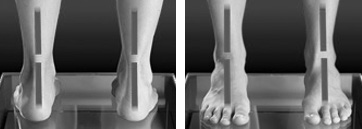 Are neutral feet common?
Are neutral feet common?
About a quarter of the population have a neutral foot type. It is also possible for one foot to be neutral while the other over- or underpronates or has excessive supination.
How do I tell if I have a neutral foot?
Even wear across the heel of your footwear can indicate a neutral foot type and gait, but it’s best to get an accurate assessment. Footbalance retailers offer a free foot analysis to help you learn more about your feet.
Is a neutral gait good?
Our bodies will adapt to any gait. What is important is if your own gait is causing your body to compensate in an inefficient or unhealthy manner. For example, have you experienced injuries that could be associated with your gait or alignment? Is your body working efficiently?
Having a neutral foot and gait contributes to good overall body alignment in which ankles, knees and hips are not strained inward or outward. This facilitates good overall biomechanics, which help prevent excess strain on the muscles, joints and spine, reducing the risk of many types of injuries.
So if I have a neutral foot I don’t really need to worry, right?
Over time foot type can change due to age, weight gain or the cumulative strain of high impact activities. Most commonly overpronation develops. Supporting your feet properly can help prevent this.
Should I wear insoles if I have a neutral foot or gait?
It depends on the insole! Don’t wear an insole that doesn’t fit your foot shape, has poor support that interferes with your gait, or is overly rigid. These can harm your feet. Many people with neutral feet enjoy wearing Footbalance custom insoles for the support, comfort and customized fit that they add to their footwear. Our patented core works dynamically with your feet to help keep muscles active and healthy to help prevent the development of overpronation.
What if I don’t have a neutral foot or gait?
Footbalance custom insoles support every foot type properly in the neutral position to aid in a balanced stance and facilitate good foot function. This can help improve body alignment and mechanics and prevent injuries.
About your arches
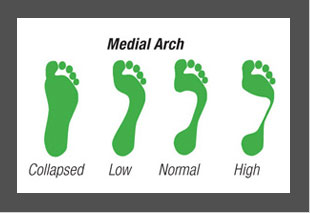 |
 |
| Custom molded Footbalance insoles provide proper support for any arch type. Our patented dynamic core gives feedback to the arches and foot muscles to help keep them strong, active and healthy. |
Medial Arch
When we talk about our arches, we’re most often referring to the medial longitudinal
arch. Spanning the heel to ball of foot, its main function is to distribute body weight and
absorb shock.
High, low or collapsed medial arches disrupt the distribution of body weight across the
foot, impairing shock absorption. Low or collapsed arches are often associated with
overpronation, while high arches are often associated with excessive supination
(underpronation). However, this is not a hard rule. You can still overpronate with high
arches or underpronate with low arches.
Transverse Arch
Most of us are unfamiliar with the transverse arch. This arch runs perpendicular to the
medial arch across the midfoot.
Many forefoot problems such as bunions, hammertoes, numbness or pain can be
associated with a collapsed or low transverse arch. Some relief may be offered by
supporting this arch to increase room for the nerves and blood vessels in the midfoot.
Footbalance insoles can be further customized by molding in support for the transverse arch.
What’s your arch type?
Footbalance dealers offer a fast, free foot analysis that will help you see your arches better and understand your personal foot type.
